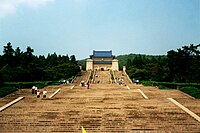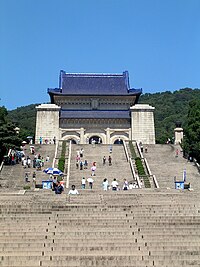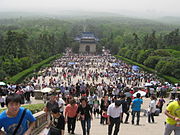|
Sun Yat-sen Mausoleum
Sun Yat-sen's Mausoleum (Chinese: 中山陵; pinyin: Zhōngshān Líng) is situated at the foot of the second peak of Purple Mountain in Nanjing, Jiangsu, China. Construction of the tomb started in January 1926, and was finished in spring of 1929. The architect was Lü Yanzhi, who died shortly after it was finished. His representative and project partner was his close friend Huang Tanpu. HistorySun, considered to be the "Father of Modern China" both in mainland China and in Taiwan, fought against the imperial Qing government and after the 1911 revolution ended the monarchy, and founded the Republic of China. Sun was born in Guangdong province of China on 12 November 1866, and died of gallbladder cancer in 1925 in Beijing, China. On the day before his death, Sun offered to preserve his body as Lenin did, and to send himself to Nanjing for burial.[1] In accordance with the wishes of Sun, the body was embalmed in the Peking Union Medical College Hospital and then temporarily stored in the Temple of Azure Clouds, Beijing, and then in Nanjing after the completion of the mausoleum. [2] Selection of the design A committee decided to host a design competition in order to collect designs for the Sun Yat-sen Mausoleum. The committee put advertisements in the newspapers on 5 May 1925, inviting architects and designers at home and abroad to send their designs. In exchange for a 10 yuan charge, the committee would provide the designer with 12 pictures of the site. The design would have to adhere to guidelines. It had to be done in a traditional Chinese style that also evoked a modern design with special and memorial substance. Not only should it evoke the Chinese architectural spirit, but also add creativity. Designers were required to insure that the proposed construction costs within 300,000 yuan (the final cost exceeded 3,000,000 Yuan). Over 40 proposals were received. On 20 September 1925, the committee convened in Shanghai, and unanimously selected Lu Yanzhi's proposal.[citation needed] The mausoleum was designed by Lu Yanzhi and completed by Poy Gum Lee between 1926 and 1929.[3] BurialOn 23 April 1929, the Chinese government appointed He Yingqin to be in charge of laying Sun to rest. On 26 May, the coffin departed from Beijing, and on 28 May, it arrived in Nanjing. On 1 June 1929, Sun was buried there. Architecture Reclining on a mountain slope, the majestic mausoleum blends the styles of traditional imperial tombs and modern architecture. Lying on the mountainside, the vault is more than 700 meters (2,300 ft) away from the paifang on the square below, which is the entrance of the mausoleum. There is a three-tier stone stand on which a huge bronze ding, an ancient Chinese vessel symbolizing power, perches. To the north of the square, the paifang towers high. Beyond is the 480-meter (1,570 ft) and 50-meter (160 ft)-wide stairway which has 392 stairs leading to the vault. On both sides, pine, cypress, and ginkgo trees guard the way. At the end of the stairway is a gate which is 16 meters (52 ft) high and 27 meters (89 ft) wide. The tri-arched marble gate is inscribed with the personal motto of Sun, with four Chinese characters written by him, "Tian Xia Wei Gong" ("天下爲公") which means "What is under heaven is for all". Inside the gate, there is a pavilion in which a 9-meter (30 ft) stele is set, which is a memorial monument set by the Kuomintang (KMT). A few stairs up is the sacrificial hall and the vault.  In front of the sacrificial hall there stands a pair of huabiao, ancient Chinese ornamental columns, which are 12.6 meters high. The sacrificial hall is actually a palace of 30 meters (98 ft) in length, 25 meters (82 ft) in width, and 29 meters (95 ft) in height. In the center of the hall a 4.6-meter (15 ft)-high statue of Sun sits. The statue was sculptured out of Italian white marble. The hall's ceiling features the flag of the Kuomintang. Biographical information on Sun is available to visitors in the hall. North of the hall lies the bell-shaped vault, wherein lies the marble false sarcophagus of Sun. Sun's body is interred in a burial chamber 5m below the marble false sarcophagus in a bronze coffin. Architectural influence of the Mausoleum's design is evident in Taiwan's Chiang Kai-shek Memorial Hall. Sun Yat-sen Mausoleum Scenic Area is located on the north side of Zijin Mountain Road in the Zhongshan Scenic Area at the southern foot of Zijin Mountain in the east of Nanjing City, Jiangsu Province, China. The core of the Sun Yat-sen Mausoleum Scenic Area is the Sun Yat-sen Mausoleum, located at the southern foot of Zhongmaofeng in Zhongshan Mountain. It is the tomb of the great democratic revolution pioneer Dr. Sun Yat-sen. The mausoleum building of Sun Yat-sen Mausoleum is symmetrical on the central axis. From the archway, tomb passage, mausoleum gate, stele pavilion to the memorial hall and tomb chamber, the horizontal distance is 700 meters, and the height difference is 70 meters. There are 392 stone steps and 10 platforms, all made of white granite and reinforced concrete. Frame, covered with blue glass tiles. It is known as "the first mausoleum in the history of modern Chinese architecture". The total area of the Sun Yat-sen Mausoleum Scenic Area is 3.22 square kilometers, including the Sun Yat-sen Mausoleum and its surrounding music stage, Xiaojing Tripod, Yangzhi Pavilion, Liuhuixie, Xingjianting, Guanghua Pavilion, Sun Yat-sen Memorial Hall, Purple Mountain Adventure Park and other scenic areas Other related attractions. High profile visits In a historical documentary,[4] Chiang Kai-shek, former President of the Republic of China, officiated the opening and paid his visit to Mausoleum reporting his victory of the Northern Expedition to unify China in 1929. Chiang also made a second visit in summer of 1946 after the conclusion of the Second World War to report the victory for his cause that mainland China was once again in Chinese sovereignty.[4] On 27 April 2005, Kuomintang (KMT) Chairman Lien Chan, his wife, and other KMT members visited the Mausoleum. It was the first visit of KMT members to the site since 1949. On 15 November 2006, a visit was made to the mausoleum by Sun's granddaughter, Sun Huiying, who was by then over eighty years old. In May 2008, Wu Po-hsiung became the second ruling KMT Chairman to visit the Sun Yat-sen Mausoleum since 1949. There were concerns that the 392 steps leading to the tomb would be too taxing given Wu's leg injuries. On 12 February 2014, Wang Yu-chi became the first ROC government official in office to visit the site after the end of the Chinese Civil War in 1949.[5] On 31 October 2016, KMT chairwoman Hung Hsiu-chu visited the mausoleum during her mainland trip for the Cross-strait Peace Development Forum.[citation needed] Former ROC president Ma Ying-Jeou visited the mausoleum on 28 March 2023.[6] ModificationsIn 1981, Lily Sun, a granddaughter of Sun Yat-sen, visited the mausoleum. The flag of the KMT had been removed from the ceiling at the time of her visit, but was later restored. In May 2011 on another visit, she was surprised to find the four characters "General Rules of Meetings" (會議通則), a document that Sun wrote in reference to Robert's Rules of Order had been removed from a stone carving.[7] Gallery
See also
References
External linksWikimedia Commons has media related to Sun Yat-sen Mausoleum. |
||||||||||||||||||||||||||








